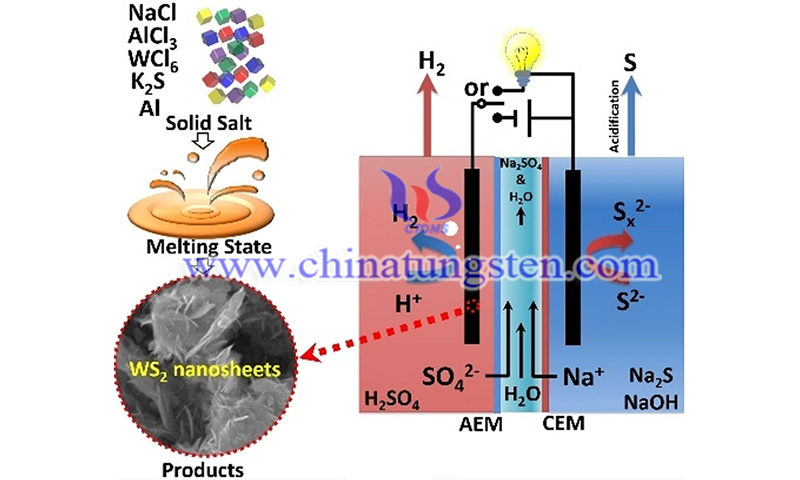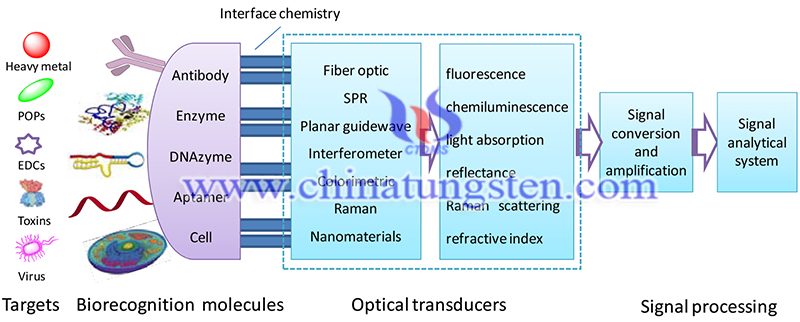Tungsten Disulfide Nanomaterials for Applications of Optical Biosensors
- Details
- Category: Tungsten Information
- Published on Friday, 12 August 2022 18:46
With the development of nanotechnology, tungsten disulfide nanomaterials (WS2NM) have been a new choice for optical biosensors. Researchers reported the use of a simple method to create a hybrid material consisting of WS2 nanosheets and hydroxylated MWCNTs (WS2/MWCNTs-OH). The substrate was screen-printed carbon electrodes (SPCE), which has the advantage of requiring minimal cost and being disposable and energy efficient. Modification with WS2/MWCNTs-OH composites improved the rate of sensitive and selective behavior.
WS2-based optical biosensor. When analytes and recognition components are combined to form a complex, optical biosensor can measure their surface changes by using optical instruments. Optical fibers, evaporative wave fibers, resonance mirrors, time-resolved fluorescence, interferometry, and surface plasmon resonance-based biosensors are different types of optical biosensors. These biosensors can be classified into two categories: direct and indirect biosensors.
Direct optical biosensors require complexes on the transducer surface to generate signals, while indirect optical biosensors involve fluorophores or chromophores as their labels to recognize binding events and amplify signals.

(Picture source: Luocai Yi/Angew. Chem. Int. Ed)
Tungsten disulfide (WS2) QD can be a good candidate due to its basic optical and electrical characteristics exhibiting excellent fluorescence characteristics. WS2-QDs have been applied as a validated probe for dopamine (DA) fluorescence detection in colon cancer assessment and detection of c-Met protein in serum samples.
In some studies, WS2 was embedded between metal and graphene layers to increase biosensor efficiency. Considering the ability of WS2 to be a suitable substrate for immobilizing biological species due to its two-dimensional covalent network, Pingyao Wang et al. reported the development of a fluorescent probe by using two-dimensional WS2 nanosheets and inducer-modified core-shell upconversion nanoparticles as acceptor and donor, respectively.
This novel, sensitive and selective biosensor can be applied for rapid and specific quantitative detection of E. coli. Moreover, the WS2 nanosheets can act as excellent energy receivers due to the wide absorption spectrum they contain, thus increasing their efficiency. Thus, this fluorescent biosensor can be a platform to observe different bacterial pathogens by varying the relevant specific inducers.
The development of conductivity and basic structural conductivity of WS2NM is important for designing biosensors. WS2NM shows excellent electrical conductivity in electronic and biosensor devices. Hexagonal crystals are the basic structural unit of two-dimensional tungsten disulfide nanomaterials, in which two sulfur atoms are bonded to one tungsten atom to form an S-W-S interlayer. The bonding of the S-W-S layer is caused by weak van der Waals forces.
WS2 nanosheets have successfully gained recognition in various fields in optical biosensors due to their huge specific surface area, good electrical conductivity, and unique electronic structure.
WS2 nanosheets contain a single crystal structure with a unique sheet and porous shape along with a significantly high specific surface area and electronic standard. A practical approach to improve electromagnetic shielding effectiveness is to add conductive nanotubes to an insulating polymer matrix. The work of Jan Macutkevic et al. claims that the addition of nanotubes to an insulating polymer matrix can effectively improve electromagnetic shielding performance due to their high aspect ratio.

(Picture source: Feng Long/ Sensors)
Cited article: Niknam S., Ahmad Dehdast S., Pourdakan O., Shabani M., Kazem Koohi M. Tungsten Disulfide Nanomaterials (WS2NM) Application in Biosensors and Nanomedicine, A review. Nanomed Res J, 2022; 7(3): 214-226. DOI: 10.22034/nmrj.2022.03.001
- Tungsten Manufacturer & Supplier, Chinatungsten Online: www.chinatungsten.com
- Tungsten News & Prices of China Tungsten Industry Association: www.ctia.com.cn
- Molybdenum News & Price: news.molybdenum.com.cn
- Tel.: 86 592 5129696; Fax: 86 592 5129797; Email: sales@chinatungsten.com



 sales@chinatungsten.com
sales@chinatungsten.com